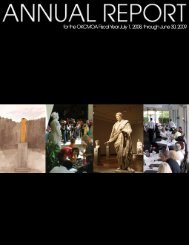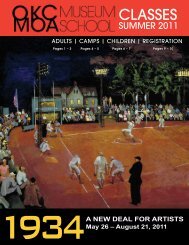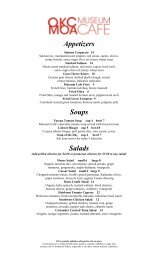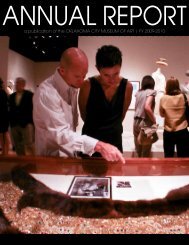Roman Art from the Louvre Educators' Resource Guide
Roman Art from the Louvre Educators' Resource Guide
Roman Art from the Louvre Educators' Resource Guide
You also want an ePaper? Increase the reach of your titles
YUMPU automatically turns print PDFs into web optimized ePapers that Google loves.
34<br />
Discussion Starters<br />
1. What material was used for <strong>the</strong><br />
Aphrodite and Eros sculpture? How do<br />
you think <strong>the</strong> choice of material affected<br />
<strong>the</strong> artist’s work and <strong>the</strong> appearance of <strong>the</strong><br />
final piece? How would <strong>the</strong> sculpture be<br />
different if it were larger and carved in<br />
stone? Why do you think <strong>the</strong> artist chose<br />
to make it at this small size?<br />
2. Many gods and goddesses are<br />
identified by items <strong>the</strong>y are commonly<br />
depicted holding or wearing. These items<br />
are referred to as attributes. What is<br />
Aphrodite holding in her upraised hand?<br />
Why do you think she is depicted in <strong>the</strong><br />
nude?<br />
3. What is a myth? Can you name any<br />
gods or goddesses? What do you know<br />
about Aphrodite and Eros? Discuss <strong>the</strong><br />
myths associated with <strong>the</strong>m.<br />
4. Compare this small figure to <strong>the</strong><br />
Fragment of a Relief of a Double<br />
Suovetaurilia Sacrifice (no. 4). Have <strong>the</strong><br />
students discuss <strong>the</strong> context in which<br />
each artwork was viewed. How are <strong>the</strong>se<br />
objects similar? How are <strong>the</strong>y different?<br />
How is scale used to enhance <strong>the</strong><br />
functions of <strong>the</strong> object? What are some<br />
symbols related to <strong>the</strong> practice of modern<br />
religions? How are <strong>the</strong>se symbols<br />
represented in works of art, and where are<br />
<strong>the</strong>y displayed? In a public or a private<br />
setting?<br />
Activity: Exploring Mythology<br />
Materials: paper, pencils, costumes<br />
Procedure:<br />
1. Ask each student to choose a <strong>Roman</strong><br />
god to research. Each student should<br />
select a different god.<br />
8. Aphrodite and Eros<br />
Imperial <strong>Roman</strong> era<br />
Discovered in Yakhmour (Syria)<br />
Bronze<br />
H. 9H in.<br />
Musée du <strong>Louvre</strong>; Gift 1967, formerly in <strong>the</strong> Péretié collection and <strong>the</strong><br />
Boisgelin-De Clercq collection (BR 4427–inv. mne 2)<br />
A symbol of love and fertility, <strong>the</strong> goddess Aphrodite was associated with<br />
women of all ages. The goddess often had a place on <strong>the</strong> family altar,<br />
where she was worshipped by <strong>the</strong> mistress of <strong>the</strong> house. Aphrodite figurines<br />
found in women’s tombs suggest that she guided <strong>the</strong>m in <strong>the</strong> afterlife<br />
as well. The large number of bronze and terracotta statuettes of Aphrodite<br />
discovered in <strong>the</strong> Middle East demonstrates <strong>the</strong> popularity of this deity<br />
throughout <strong>the</strong> empire. By <strong>the</strong> second century B.C., <strong>the</strong> Greek goddess<br />
Aphrodite had also become associated with Venus, a native Latin deity. In<br />
o<strong>the</strong>r parts of <strong>the</strong> empire, Aphrodite was assimilated with important local<br />
goddesses, such as Isis-Hathor in Egypt, Atargatis in Syria, and Astarte in<br />
Phoenicia (what is now <strong>the</strong> Mediterranean coast of Syria).<br />
This small bronze statuette shows Aphrodite in a classical pose, with her<br />
weight on her left leg and her right leg slightly bent. In her upraised right<br />
hand is an apple, one of her chief attributes, which, along with <strong>the</strong> small<br />
crown that adorns her head, characterizes <strong>the</strong> figurine as <strong>the</strong> goddess.<br />
Eros, her son, appears by her feet, holding objects of Aphrodite’s toilette in<br />
his hands: a tiny flask for perfumed oil and a mirror. Upon close examination<br />
<strong>the</strong> Eros is less carefully executed than <strong>the</strong> principal figure and is quite<br />
small in proportion to Aphrodite. It is possible that <strong>the</strong> Eros was added at<br />
a later time.<br />
2. Ask students to prepare a presentation<br />
for <strong>the</strong> class on <strong>the</strong>ir chosen god.<br />
Encourage students to be as creative as<br />
possible for <strong>the</strong>ir presenta tions. Suggest<br />
that <strong>the</strong>y dress up as <strong>the</strong>ir chosen god, tell<br />
a story as if <strong>the</strong>y were <strong>the</strong> god, or act out<br />
an important moment in <strong>the</strong> god’s life.<br />
3. As a class, discuss <strong>the</strong> use of this<br />
imagery in Aphrodite and Eros. Why do<br />
you think this imagery was chosen?<br />
See also <strong>the</strong> activity “Reading and Writing<br />
about Mythology” (p. 23).
















